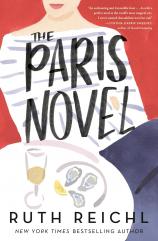The Paris Novel
Review
The Paris Novel
Ruth Reichl introduces Stella St. Vincent, a shy young woman whose mother had emotionally abandoned her and whose father was unknown to her, as the heroine of what turns out to be her own story, THE PARIS NOVEL. Stella is living a tidy, boxed-in, closed-off life. A brilliant literary reviewer who spends her hours reading huge books, visiting museums and retreating, she seems content.
However, Stella is jolted into action when her mother unexpectedly dies and leaves her a modest amount of money with only the message “Go to Paris.” She reluctantly agrees, and in the opening chapter set in 1983, we watch Stella arrive in Paris, live modestly and eat sensibly. One morning, she admires a dress in a most extraordinary shade of violet and is drawn to enter the shop, Robes des Rêves. Stella means only to touch it, perhaps to see if it is velvet. But the eccentric shopkeeper appears to have been waiting for her; she goes into a back room and presents her with another gown. She insists that Stella try on this cloud of a dress, and somehow it becomes an embrace, comforting her as a lullaby might.
"THE PARIS NOVEL includes exquisite details and pages of descriptions that opened Paris for me, and I think that can happen for you too."
Stella surrenders to the dress’s scent of apricots and vanilla; looking into a mirror, she sees herself anew, seductive and sensual. With caution and trepidation, she and the transformative dress begin truly discovering Paris.
Reichl starts and ends THE PARIS NOVEL with loving tributes to the late Susan Kamil, her longtime editor and friend, without whose encouragement this particular book would not have been written. Kamil loved the opening scenes with the dresses (as did I), and she wanted to know more. Reichl complied.
Stella’s slow, generous absorption of Paris happens on many levels. The award-winning chefs, with their elaborate presentation and care for each and every detail of a meal, introduce her to rich, tantalizing foods. She had read about them, but the tastes, smells and textures are exquisite. Her burgeoning appreciation of foods and growing acceptance of the culinary world’s delights is one key to her love of Paris.
The art world and its mysteries introduce Stella to an 1863 Manet painting with an unknown but captivating model, Olympia, instilling in Stella an urge to know her. She begins a slow, determined search for the woman’s story, wanting to understand her origins and how she ultimately navigated her life in an unfair world of men and power.
Stella grows to love the Parisian markets, submerges herself in the French countryside, and trusts the shopkeepers and their precise attention to their produce. However, most important and exciting --- and what is at the heart of the book --- is Stella’s growing awareness of what it feels like to be accepted and become part of something larger than herself.
A side note: My son-in-law saw me reading THE PARIS NOVEL, and he wondered if I had been to Paris. It’s a fair question that came with a disappointing answer: “No.” Location writing may lose meaning for readers if they haven’t been there. They cannot be reminded of the streets as the characters walk them, and they cannot smell, hear or see exactly what the characters do. The stories about Carlisle, PA, where I live, become more alive and fascinating because I know the LeTort Springs or the Presbyterian church where George Washington attended a morning service.
However, Ruth Reichl’s writing is so vivid that I felt like I did walk with Stella along the cobblestone courtyard of the Louvre. I gasped at the palace-like library of the Département des Étampes. I tasted the tartness of lemons and the wheels of earthy cheese. THE PARIS NOVEL includes exquisite details and pages of descriptions that opened Paris for me, and I think that can happen for you too.
Reviewed by Jane T. Krebs on April 26, 2024
The Paris Novel
- Publication Date: April 23, 2024
- Genres: Fiction, Historical Fiction, Women's Fiction
- Hardcover: 288 pages
- Publisher: Random House
- ISBN-10: 0812996305
- ISBN-13: 9780812996302










